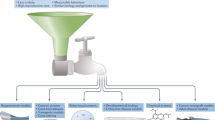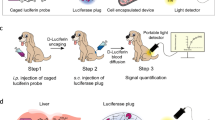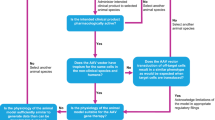Abstract
In vivo reporter gene and imaging technologies have the potential to contribute to the drug discovery pipeline in several areas. They provide systems that enable the study of the biochemical activity of a target in disease, and in response to a drug, to be monitored over periods of time, and offer more accurate methods of measuring pharmacodynamics and toxicity. Although reporter-gene technology is in its infancy, with further refinement reporter animals could become a valuable tool in the early stages of target and lead identification and preclinical drug development.
This is a preview of subscription content, access via your institution
Access options
Subscribe to this journal
Receive 12 print issues and online access
$209.00 per year
only $17.42 per issue
Buy this article
- Purchase on Springer Link
- Instant access to full article PDF
Prices may be subject to local taxes which are calculated during checkout


Similar content being viewed by others
References
Gershell, L. J. & Atkins, J. H. A brief history of novel drug discovery technologies. Nature Rev. Drug Discov. 2, 321–327 (2003).
Zambrowicz, B. P. & Sands, A. T. Knockouts model the 100 best-selling drugs — will they model the next 100? Nature Rev. Drug Discov. 2, 38–51 (2003).
Knowles, J. & Gromo, G. A guide to drug discovery: target selection in drug discovery. Nature Rev. Drug Discov. 2, 63–69 (2003)
Wang, Y., DeMayo, F. J., Tsai, S. Y. & O'Malley, B. W. Ligand-inducible and liver-specific target gene expression in transgenic mice. Nature Biotechnol. 15, 239–243 (1997).
Solomin, L. et al. Retinoid-X receptor signalling in the developing spinal cord. Nature 395, 398–402 (1998).
Mata De Urquiza, A., Solomin, L. & Perlmann, T. Feedback-inducible nuclear-receptor-driven reporter gene expression in transgenic mice. Proc. Natl Acad. Sci. USA 96, 13270–13275 (1999).
Ciana, P. et al. Engineering of a mouse for the in vivo profiling of estrogen receptor activity. Mol. Endocrinol. 15, 1104–1113 (2001).
Nagel, S. C., Hagelbarger, J. L. & McDonnell, D. P. Development of an ER action indicator mouse for the study of estrogens, selective ER modulators (SERMs), and xenobiotics. Endocrinology 142, 4721–4728 (2001).
Rossant, J., Zirngibl, R., Cado, D., Shago, M. & Giguere, V. Expression of a retinoic acid response element-hsplacZ transgene defines specific domains of transcriptional activity during mouse embryogenesis. Genes Dev. 5, 1333–1344 (1991).
Montoliu, L., Blendy, J. A., Cole, T. J. & Schutz, G. Analysis of perinatal gene expression: hormone response elements mediate activation of a lacZ reporter gene in liver of transgenic mice. Proc. Natl Acad. Sci. USA 92, 4244–4248 (1995).
Ciana, P. et al. In vivo imaging of transcriptionally active estrogen receptors. Nature Med. 9, 82–86 (2003).
Fukumura, D. et al. Tumor induction of VEGF promoter activity in stromal cells. Cell 94, 715–725 (1998).
Lyons, S. K., Meuwissen, R., Krimpenfort, P. & Berns A. The generation of a conditional reporter that enables bioluminescence imaging of Cre/loxP-dependent tumorigenesis in mice. Cancer Res. 63, 7042–7046 (2003).
Yamaguchi, M., Saito, H., Suzuki, M. & Mori, K. Visualization of neurogenesis in the central nervous system using nestin promoter-GFP transgenic mice. Neurorep. 11, 1991–1996 (2000).
Schmidt-Ullrich, R. et al. NF-κB activity in transgenic mice: developmental regulation and tissue specificity. Development 122, 2117–2128 (1996).
Carlsen, H., Moskaug, J. O., Fromm, S. H. & Blomhoff, R. In vivo imaging of NF-κB activity. J. Immunol. 168, 1441–1446 (2002).
Huang, C. et al. Blocking activator protein-1 activity, but not activating retinoic acid response element, is required for the antitumor promotion effect of retinoic acid. Proc. Natl Acad. Sci. USA 94, 5826–5830 (1997).
Bruning, J. C. et al. Development of a novel polygenic model of NIDDM in mice heterozygous for IR and IRS-1 null alleles. Cell 88, 561–572 (1997).
Su, L. -K. et al. Multiple intestinal neoplasia caused by a mutation in the murine homolog of the APC gene. Science 256, 668–670 (1992).
DiMasi, J. A., Hansen, R. W. & Grabowski, H. G. The price of innovation: new estimates of drug development costs. J. Health Econ. 22, 151–185 (2003).
Preziosi, P. Science, pharmacoeconomics and ethics in drug R&D: a sustainable future scenario? Nature Rev. Drug Discov. 3, 521–526 (2004).
Geiling, E. M. K. & Cannon, P. R. Pathologic effects of elixir of sulphanilamide (diethylene glicol) poisoning. JAMA 111, 919–926 (1938).
Rawlins, M. D. Cutting the cost of drug development? Nature Rev. Drug Discov. 3, 360–364 (2004).
Freireich, E. J., Gehan, E. A., Rall, D. P., Schmidt, L. H. & Skipper, H. E. Quantitative comparison of toxicity of anticancer agents in mouse, rat, hamster, dog, monkey, and man. Cancer Chemother. Rep. 50, 219–244 (1966).
Xie, W. & Evans, R. M. Pharmaceutical use of mouse models humanized for the xenobiotic receptor. Drug Discov. Today 7, 509–515 (2002).
Kenakin, T. Predicting therapeutic value in the lead optimization phase of drug discovery. Nature Rev. Drug Discov. 2, 429–438 (2003).
Verkhusha, V. V. & Lukyanov, K. A. The molecular properties and applications of Anthozoa fluorescent proteins and chromoproteins. Nature Biotechnol. 22, 289–296 (2004).
Dmitriy, M. et al. Kindling fluorescent proteins for precise in vivo photolabeling. Nature Biotechnol. 21, 191–194 (2003).
Paulmurugan, R. et al. Noninvasive imaging of protein-protein interactions in living subjects by using reporter protein complementation and reconstitution strategies. Proc. Natl Acad. Sci. USA 99, 15608–15613 (2002).
Willard, F. S. et al. Fluorescence-based assays for RGS box function. Methods Enzymo. 389, 56–71 (2004).
Ray, P. et al. Noninvasive quantitative imaging of protein–protein interactions in living subjects. Proc. Natl Acad. Sci. USA 99, 3105–3110 (2002).
Massoud, T. F. & Gambhir, S. S. Molecular imaging in living subjects: seeing fundamental biological processes in a new light. Genes Dev. 17, 545–580 (2003).
Contag, C. H. & Bachmann, M. H. Advances in in vivo bioluminescence imaging of gene expression. Annu. Rev. Biomed. Eng. 4, 235–60 (2002).
Hadjantonakis, A. K., Dickinson, M. E., Fraser, S. E. & Papaioannou, V. E. Technicolour transgenics: imaging tools for functional genomics in the mouse. Nature Rev. Genet. 4, 613–625 (2003).
Louie, A. Y. et al. In vivo visualization of gene expression using magnetic resonance imaging. Nature Biotechnol. 18, 321–325 (2000).
Moore, A. et al. Human transferrin receptor gene as a marker gene for MR imaging. Radiology. 221, 244–250 (2001).
Liang, Q. et al. Noninvasive imaging of reporter gene expression in living subjects. Adv. Cancer Res. 92, 29–80 (2004).
Rudin, M. & Weissleder, R. Molecular imaging in drug discovery and development. Nature Rev. Drug Discov. 2, 123–131 (2003).
Di Lorenzo, D. et al. Isomer specific activity of DDT with estrogen receptor in adult and sucling mice. Endocrinology 143, 4544–4551 (2002).
Author information
Authors and Affiliations
Corresponding author
Ethics declarations
Competing interests
The authors declare no competing financial interests.
Related links
Rights and permissions
About this article
Cite this article
Maggi, A., Ciana, P. Reporter mice and drug discovery and development. Nat Rev Drug Discov 4, 249–255 (2005). https://doi.org/10.1038/nrd1661
Issue Date:
DOI: https://doi.org/10.1038/nrd1661
This article is cited by
-
Alternatives to animal experimentation for hormonal compounds research
Genes & Nutrition (2009)
-
Development of a bicistronic vector for multimodality imaging of estrogen receptor activity in a breast cancer model: preliminary application
European Journal of Nuclear Medicine and Molecular Imaging (2008)
-
The mighty mouse: genetically engineered mouse models in cancer drug development
Nature Reviews Drug Discovery (2006)
-
Nutritional flavonoids impact on nuclear and extranuclear estrogen receptor activities
Genes & Nutrition (2006)



